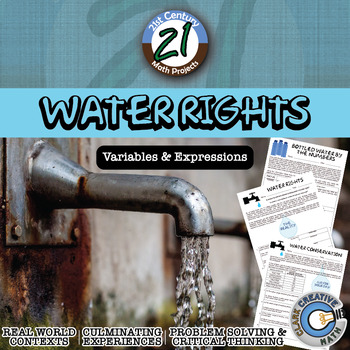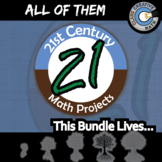Water Rights - Expressions - Math Project - Distance Learning Compatible
- Zip
- Google Apps™

Also included in
- The project is the core of what I have built my classroom around. Scaffolding learners to real world projects. This bundle includes the 105+ math projects I have written. This is over 2,700 pages of content.21st Century Math Projects each scaffold through an authentic context and math skill buildingPrice $395.00Original Price $564.00Save $169.00
Description
In this 21st Century Math Project, let your students explore the mathematics around life most valuable resource... water. Through investigating bottled water, staggering international statistics and the realities of water conservation, students will be asked to construct expressions and equations around H2O.
In this 23 page PDF, you will be given a mapping to the Content Standards, an outline for how to implement the project, 4 different assignments for students to use, 1 project and an answer key. ***THIS PRODUCT HAS BEEN UPDATED WITH A GOOGLE SLIDES INTERACTIVE VERSION INCLUDED. REDOWNLOAD IF YOU HAVE IT ALREADY***
Download the preview to see pretty much everything!
In “Bottled Water by the Numbers” students begin practicing translating verbal expressions into algebra and evaluating or solving as necessary.
In “Water Rights” students will be immersed in international statistics about the realities or our present day water situation, the challenges of collecting water and the health effects of the situation. Students will write and evaluate algebraic expressions.
In “Carrying the Load” you can have student experience the realities of carrying water in this integrated hands-on assignment.
In “Water Conservation” students will use tables of data from the EPO and PackH2O to write and evaluate verbal expressions. They will be required to make up their own problems throughout.
In “Water Rights: Take Action Infographic” students should use information from their research to design their own digital infographic.
You may be interested in the following discounted bundles. SAVE $$$!
•21st Century Math Projects -- All the Projects
Need an Entire Curriculum?
•21st Century Pre-Algebra –- the Entire Curriculum
•21st Century Algebra –- the Entire Curriculum
For more tips, tricks and ideas check out the Clark Creative Education Blog
And join our community where I post ideas, anecdotes, elaborations & every once in a while I pass out TPT gift cards! And jokes! I do jokes too!






